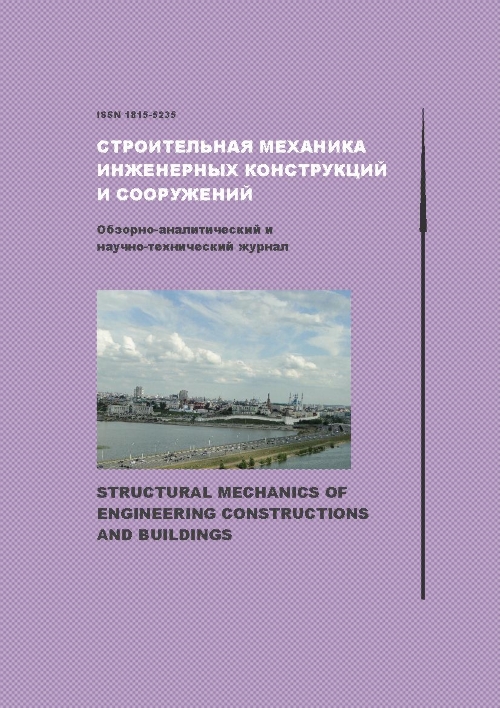No 1 (2012)
- Year: 2012
- Articles: 14
- URL: https://journals.rudn.ru/structural-mechanics/issue/view/690
Articles
 3-7
3-7


DISPLACEMENTS AND STRAINS OF COUNTOURS OF THE UNDERGROUND STRUCTURES IN CRACKED ROCK MASSIF
Abstract
Problems of strain concentration and distribution of displacements around the contour of underground structures which are located in anisotropic and transverse isotropic rock massif are solved with numerical solution based on boundary integral equations.
Structural Mechanics of Engineering Constructions and Buildings. 2012;(1):8-16
 8-16
8-16


SPATIAL CALCULATION OF INELASTIC COMPOSITE BARS
Abstract
We consider the deformation calculation of inelastic composite bars of variable cross section along the length of variable-stiffness relationships shift. The solution is based on an overall A.R. Rzhanitsyn's theory of elastic spatial working composite rods. A formula to determine the equivalent modules strains previously obtained by the author, which taking into account the development of inelastic strains in wet composite rod, the compressibility and shear deformation of the material branches are used. The variable stiffness of the inelastic composite rod in torsion is taken into account.
Structural Mechanics of Engineering Constructions and Buildings. 2012;(1):17-23
 17-23
17-23


STRESS RELAXATION OF REINFORCED CONCRETE BEAM UNDER AXIAL LOAD
Abstract
The normal stress distribution due to the axis variable force is determined in the concrete and in reinforcement. The creep and structural damages are accounted. The solution the corresponding relaxation problem is based on the quasi-linear rheological state equation.
Structural Mechanics of Engineering Constructions and Buildings. 2012;(1):24-29
 24-29
24-29


REDUCTION OF RIGID ROLLED U-SHAPED ARCH PROFILETO A PROFILE WITH T-SECTION
Abstract
Assessment of the reduction rigid rolled U-shaped arch profiles features finds difficulties first of all in their geometrical form and functioning. In this article there was made a calculation of reduction of rigid rolled U-shaped arch. While taking into account the complication of their assessment, two main calculating methods were considered. The first one is experimental, while the other is solid models modeling, taking into account the rolling of the profiles. Within the scope of this work the second method of reduction rigid rolled U-shaped arch profiles features assessment was examined. In this case the calculation of the reduction rolled profiles proceed along their length with the conversion their form to an T-shaped section. The profile modeling was based on the Solid Works software package. The results are the estimation of reduction rigid rolled U-shaped arch profiles features as well as the substantiation of the T-shaped section conversion.
Structural Mechanics of Engineering Constructions and Buildings. 2012;(1):30-37
 30-37
30-37


THE PERFECTION OF A METHOD OF NUMERICAL MODELING STEEL-AND-REINFORCED CONCRETE PRESSURE WATER PIPES
Abstract
The results of calculations of stress-strain state of steel-and-reinforced concrete pressure water pipes of the hydro station are presented. It was made with the help of a method of numerical modeling derived by the author. Numerical results were compared with experimental data obtained before.
Structural Mechanics of Engineering Constructions and Buildings. 2012;(1):37a-41
 37a-41
37a-41


Forming A Structural Design USING genetic algorithm and Delaunay tetrahedral partition
Abstract
The computing circuit for finding the optimal shape of structural design, based on the use of algorithms Delaunay tetrahedral partition with constraints and evolutionary modeling is developed. The structure design is synthesized on a set of given set of nodes in a fixed number of rods. Formed structures are optimized using a genetic algorithm the criterion of minimum weight design. The example of synthesis in terms of a rectangular plate illustrates the structural performance of the proposed approach to forming rod systems of this type.
Structural Mechanics of Engineering Constructions and Buildings. 2012;(1):41a-49
 41a-49
41a-49


ANALYTICAL CALCULATION OF THE SPATIAL ROD SYSTEM
Abstract
The system Maple is used to solve the statics problem of an elastic space statically determinate truss. The algorithm of calculation is given. The inductive method of obtaining solutions for an arbitrary number of rods in the farm is used. The relation of the height of the truss on the length detected the value, for which the deflection increases indefinitely. Optimal truss size is found.
Structural Mechanics of Engineering Constructions and Buildings. 2012;(1):49a-53
 49a-53
49a-53


 53a-57
53a-57


 58-61
58-61


 62-64
62-64


STability of linear stochastic systems
Abstract
In this paper the problem of modeling the movement of the linear system under the influence of determined and stochastic parametric load had been studied by the example of cable-stayed girder. The aerodynamic stability of similar systems had been analyzed. There are two cases compared when pulsation wind component is Gauss random stationary process with a spectral density of Davenport, and spectral density of Kaimal.
Structural Mechanics of Engineering Constructions and Buildings. 2012;(1):65-69
 65-69
65-69


 70-73
70-73


THE COMPARISON OF BEHAVIOR OF AN ARCH OF ROLLED METAL THIN-SHEET PROFILES LOADED BY WIND LOAD ACCORDING TO THE STANDARDS AND LOADED BY LOAD DERIVED WITH THE HELP OFCOMPUTER MODELING
Abstract
There was made a comparison in this article of rolled metal thin-sheet profiles arch's behavior features, which was loaded with standard wind load on the one hand and with load, obtained by means of computer modeling on the other hand. The research was carried out in the following sequence: first of all there was made a substitution of the metal thin-sheet profiles U-formed arch for the plain arch with an equivalent flexural rigidity, then the load of the arch with wind load in compliance with the calculating data of the wind flow in the virtual wind tunnel and finally execution of analysis and comparison of final results. The arch modeling as well as the virtual wind tunnel modeling was based on the Solid Works software package by means of the method, stated in the previous publications. The theoretical and methodological basis of the research is the Navier-Stokes equation and the equation of the condition of the fluid medium's components. The results are the differentiation of three pressure zones on the arch, depending on wind trajectory and speed, as well as the comparison of the maximal redial arch shifts under two types of wind loads.
Structural Mechanics of Engineering Constructions and Buildings. 2012;(1):74-80
 74-80
74-80
















